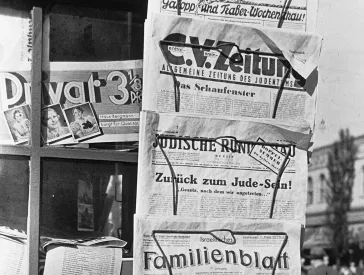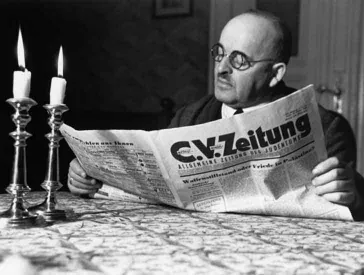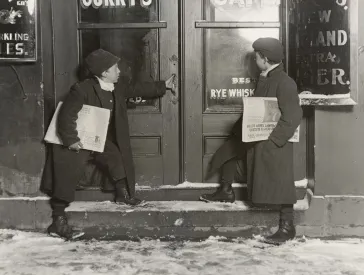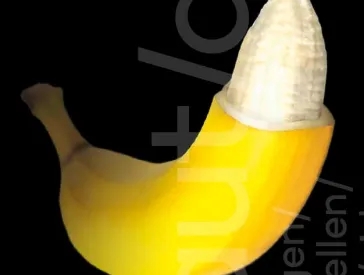“Snip It! Stances on Ritual Circumcision”
Press Information
Press Release, Thu 23 Oct 2014
- New perspectives: Looking at the ritual from Jewish, Muslim and Christian viewpoints that go far beyond the recent “circumcision debate”
- Deeper insights: Facts on the religious, cultural and historical significance of circumcision
- Broad spectrum: From the ritual's ancient roots to popular culture in US American TV series
On 24 October, "Snip It! Stances on Ritual Circumcision" (24 October 2014 to 1 March 2015) opened at the Jewish Museum Berlin. Incisive in every sense of the term, the exhibition explores male circumcision as such, but also reflects a sense among many Jews and Muslims that they and their religious traditions are not welcome in Germany. Against this backdrop, the Jewish Museum Berlin examines the little-known religious, cultural, and historical contexts of a millennia-old ritual in Judaism and Islam, and its reception in the Christian world.
- Contact
-
Press office
T +49 (0)30 259 93 419
presse@jmberlin.de
- Address
Jewish Museum Berlin Foundation
Lindenstraße 9–14
10969 Berlin
The Jewish Museum Berlin's exhibition was prompted by a fierce controversy that arose in May 2012, when a regional court in Cologne declared the ritual circumcision of boys to be a "bodily injury". In the discussions that ensued, labeled the "circumcision debate", the right to the free practice of religion was confronted with the child's right to physical integrity.
"I hope the exhibition will generate a deeper understanding of what the ritual circumcision of boys means and will make it possible to talk about the topic without prejudice," says Cilly Kugelmann, Program Director of the Jewish Museum Berlin.
The exhibition does not enter into the 2012 debate or pursue it further. Instead, more than sixty objects and artworks from international collections provide insights into the context of ritual circumcision. The exhibition does not shy away from documenting prejudice, and confronts visitors with the Western, "enlightened" view of Europeans onto societies that practice circumcision. At the entry to the exhibition, a World Health Organization map shows that one third of the world's male population is circumcised for religious or other reasons.
On the Knife’s Edge
The exhibition begins with the large-scale installation "On the Knife's Edge", a series of six nude sculptures from different epochs and regions. The figures, some of them life-size, direct visitors' attention to the different cultural formations of the body: from circumcision as a rite of passage in the ancient Orient, to non-European body modifications in the African world, to the Greek statue of a praying boy who conforms to the Hellenic physical ideal by being uncircumcised. Presenting circumcision as a social phenomenon, the hyperrealistic life-size sculpture Murray is circumcised, as are 70 percent of all American men.
Word Room
The core of the exhibition is a dazzlingly white room. It stages the biblical text that forms the foundation of ritual circumcision: Abraham's covenant with God, which is sealed by a physical sign. The relevant verses from Genesis (17:9–11) are mounted on the wall in three-dimensional letters, using four languages and three scripts. Starting from the Jewish concept of this Abrahamic covenant, the exhibition goes on to illuminate the topic from the perspective of all three major monotheistic religions.
The “Round Table Trialogue” takes a comparative approach to visualizing circumcision in the three Abrahamic religions. The table extends through three rooms, as a surface to display precious and visually remarkable objects from each of the three traditions.
Circumcision in Judaism
The ritual removal of the foreskin on the eighth day of life, the "brit milah" (Hebrew: "covenant of circumcision") is part of the identity of a Jewish man. Born into the Jewish people, on the basis of having a Jewish mother, his brit milah constitutes an irreversible symbol of his Jewishness. The objects show how, over the centuries, debates have often arisen on the practical aspects of fulfilling the commandment to circumcise. An example is the gradually increasing focus on hygienic standards. The objects exhibited address the medical aspects of circumcision and regional differences in the customs associated with the brit milah.
Circumcision in Islam
In Islam, circumcision (in Turkish: sünnet) is carried out at the latest by the time a boy reaches puberty. Although it is not explicitly mentioned in the Qur'an, for centuries circumcision has been an obligation and religious tradition of Muslims as a sunna, a practice based on the words, deeds, and recommendations of the Prophet Muhammad. Circumcisions are often celebrated lavishly, and the festivities are important events in the life of a boy and his family. Alongside modern and historical circumcision costumes, the exhibition prominently displays a set of Karagöz shadow puppets. In the Ottoman Empire, Karagöz puppetry formed an integral part of the entertainment at circumcision festivities.
Reception in Christianity
The Feast of the Circumcision of Christ was celebrated as a liturgical festival from Late Antiquity on. The gospel text on the circumcision and naming of Jesus (Luke 2:21) is read in churches on 1 January, the eighth day after Jesus' birth. This includes the Catholic Church, although since 1969 Catholics have celebrated 1 January not as the Feast of the Circumcision of Christ but as the Solemnity of Mary, Holy Mother of God. This chapter of the exhibition brings together masterpieces of Christian art such as Peter Paul Rubens' pious portrayal of the circumcision of Jesus – but also anti-Semitic interpretations of circumcision, reaching the extreme accusations of ritual murder. In Christianity, Paul's Epistle to the Romans ushered in a reinterpretation of physical circumcision as the circumcision of the heart.
Echo Chamber
In the final room, ten media stations reflect debates within the family and the political sphere – sometimes seriously, sometimes ironically. The clips include documentaries, feature films, contemporary TV series from Germany and the United States, and footage of the German Federal Parliament debate on the circumcision of male minors.
Accompanying and educational program
The extensive accompanying program begins on 10 November with the film Circoncision at the "Monday Movies". Among other events, on 4 December a study on the circumcision debate will be presented and discussed as part of the Jewish-Islamic Forum. On 8 February, master puppeteer Emin Şenyer will perform a Karagöz shadow theater show. The educational program offers workshops on the significance of circumcision in the monotheistic religions, tailored to school classes and teachers.
| Exhibition dates | 24 October 2014–1 March 2015 |
|---|---|
| Where | Old Building first level |
| Admission | With the museum ticket (8 €, reduced 3 €) |
The catalogue, Haut ab! Haltungen zur rituellen Beschneidung, is published by Wallstein Verlag (176 pages, 75 illustrations, 24.90 €).
The exhibition website with the exhibition trailer and a series of essays on the exhibition topic can be found at: www.jmberlin.de/snipit
Partner
Wall AG
Media partners
chrismon
Yorck Kinogruppe
zitty BERLIN
taz.die tageszeitung




